SQL Server 2016 includes more features than ever before, but it can be difficult to find the differences between versions of SQL Server.
The primary difference is the licensing model, which limits how SQL Server may be used on the server it is installed on. A majority of SQL Server features are available in both SQL Server Web and Standard editions. There are some differences around mirroring (Web can only serve as a witness), publishing (Web can only subscribe), and performance (Web does not come with SQL Profiler).
SQL Server Versions
| SQL Server edition | Definition |
|---|---|
| Enterprise | The premium offering, SQL Server Enterprise edition delivers comprehensive high-end datacenter capabilities with blazing-fast performance, unlimited virtualization, and end-to-end business intelligence — enabling high service levels for mission-critical workloads and end user access to data insights. |
| Standard | SQL Server Standard edition delivers basic data management and business intelligence database for departments and small organizations to run their applications and supports common development tools for on-premise and cloud — enabling effective database management with minimal IT resources. |
| Web | SQL Server Web edition is a low total-cost-of-ownership option for Web hosters and Web VAPs to provide scalability, affordability, and manageability capabilities for small to large scale Web properties. |
SQL Server Licensing
| SQL Server edition | Licensing Format |
|---|---|
| Enterprise | Licensed per User (CAL) or per CPU. Each license (User CAL) covers one authorized user who will access the database server. It is required to license all users who will have access to the database server. Alternatively, “unlimited” license may be purchased per CPU. It is required to license all CPUs on the server where SQL Server is running. For pricing, see SQL Server Hosting. |
| Standard | Licensed per User. Each license (User CAL) covers one authorized user who will access the database server. It is required to license all users who will have access to the database server. For pricing, see SQL Server Hosting. |
| Web | Licensed per 2 CPU cores. Licenses are provided in packs of 2, so 1 license covers 2 CPU cores. It is required to license all cores on the server where SQL Server is running. For pricing, see SQL Server Hosting. |
We provide licensing for hosted cloud servers, for all editions of SQL Server 2016. For more info, please visit SQL Server Hosting.
Scale Limits
| Feature | Enterprise | Standard | Web | Express with Advanced Services | Express |
|---|---|---|---|---|---|
| Maximum compute capacity used by a single instance – SQL Server Database Engine1 | Operating system maximum | Limited to lesser of 4 sockets or 24 cores | Limited to lesser of 4 sockets or 16 cores | Limited to lesser of 1 socket or 4 cores | Limited to lesser of 1 socket or 4 cores |
| Maximum compute capacity used by a single instance – Analysis Services or Reporting Services | Operating system maximum | Limited to lesser of 4 sockets or 24 cores | Limited to lesser of 4 sockets or 16 cores | Limited to lesser of 1 socket or 4 cores | Limited to lesser of 1 socket or 4 cores |
| Maximum memory for buffer pool per instance of SQL Server Database Engine | Operating System Maximum | 128 GB | 64 GB | 1410 MB | 1410 MB |
| Maximum memory for Columnstore segment cache per instance of SQL Server Database Engine | Unlimited memory | 32 GB2 | 16 GB2 | 352 MB2 | 352 MB2 |
| Maximum memory-optimized data size per database in SQL Server Database Engine | Unlimited memory | 32 GB2 | 16 GB2 | 352 MB2 | 352 MB2 |
| Maximum memory utilized per instance of Analysis Services | Operating System Maximum | Tabular: 16 GBMOLAP: 64 GB | N/A | N/A | N/A |
| Maximum memory utilized per instance of Reporting Services | Operating System Maximum | 64 GB | 64 GB | 4 GB | N/A |
| Maximum relational database size | 524 PB | 524 PB | 524 PB | 10 GB | 10 GB |
1 Enterprise Edition with Server + Client Access License (CAL) based licensing (not available for new agreements) is limited to a maximum of 20 cores per SQL Server instance. There are no limits under the Core-based Server Licensing model. For more information, see Compute Capacity Limits by Edition of SQL Server.
2 Applies to SQL Server 2016 SP1.
Source: https://docs.microsoft.com/en-us/sql/sql-server/editions-and-components-of-sql-server-2016
Visit docs.microsoft.com for up-to-date documentation on Microsoft SQL Server 2016.
This article applies to:
- SQL Server 2016 on Windows Server 2016
- SQL Server 2016 on Windows Server 2012 R2





